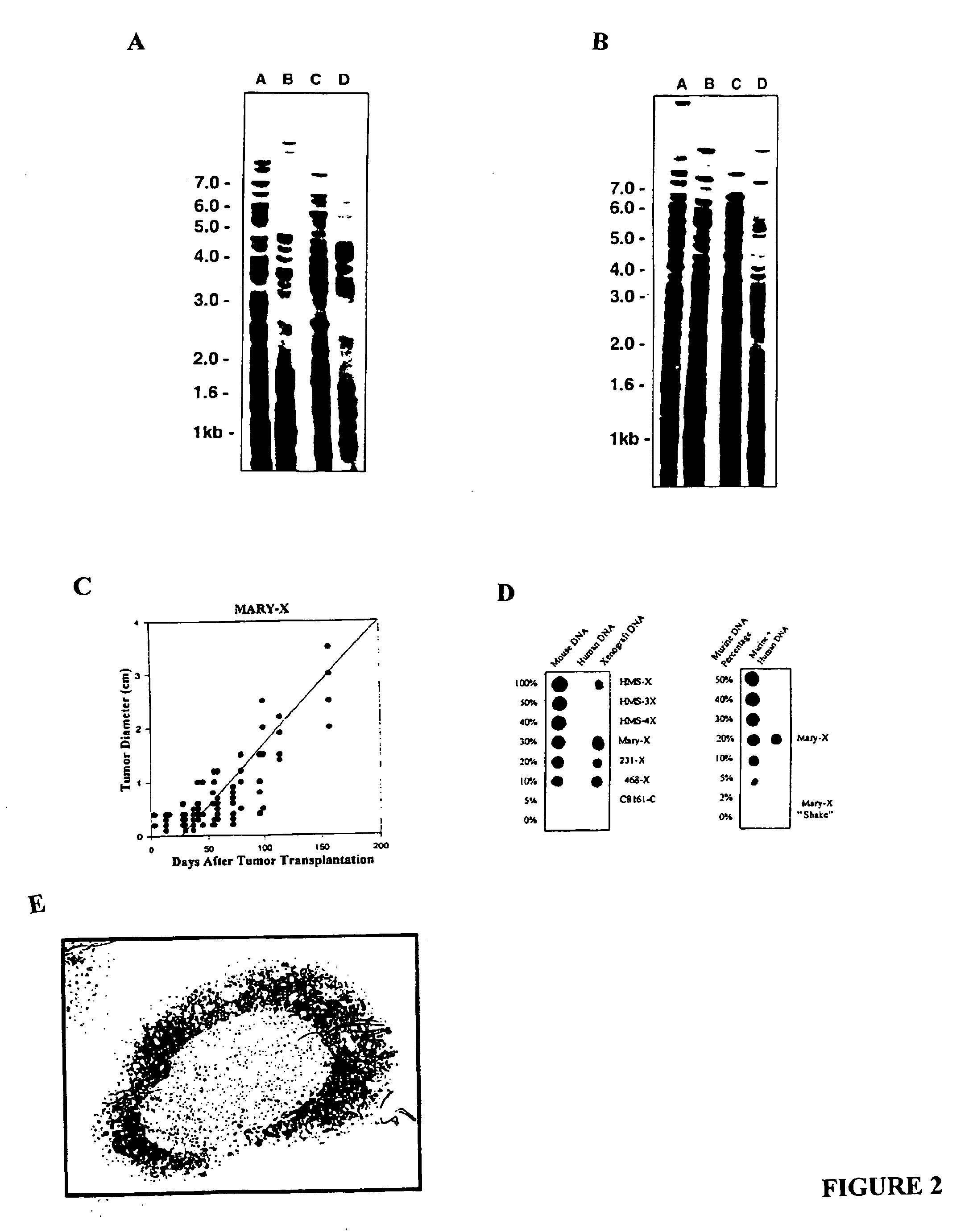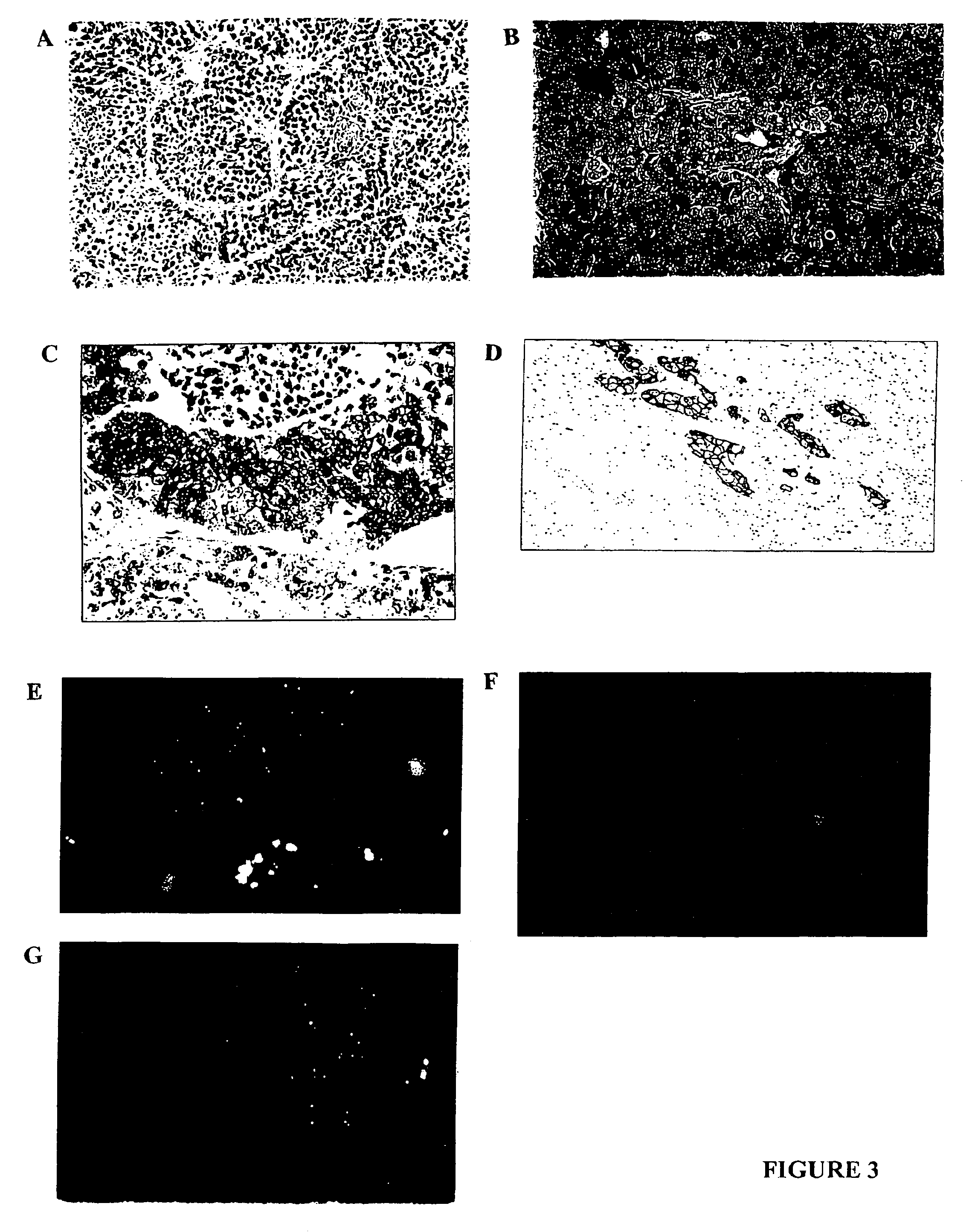Human inflammatory breast carcinoma xenograft capable of lymphovascular invasion and methods for its use
a technology of lymphovascular invasion and xenograft, which is applied in the field of human inflammatory breast carcinoma xenograft, can solve the problems of severe hampered process and lack of appropriate and clinically relevant modeling systems, and achieve the effect of preventing lymphovascular invasion
- Summary
- Abstract
- Description
- Claims
- Application Information
AI Technical Summary
Benefits of technology
Problems solved by technology
Method used
Image
Examples
example 1
Generation and Propagation of Cell lines and Xenografts
[0133]Informed patient consent and certification from the UCLA Human Subject Protection Committee was obtained prior to all studies. Approval from the Chancellor's Animal Research Committee was requested and obtained, certification ARC #95–127-11. The MARY-X xenograft was established directly from a 45 year old female who presented with a warm and erythematous breast and ill-defined mass. The mass was biopsied and diagnosed as inflammatory carcinoma exhibiting florid invasion of dermal lymphatics. Minced 1 mm3 portions of the biopsy were washed in Hank's balanced salt solution, placed in RPMI media and subsequently implanted subcutaneously in several female scid and athymic (nude) mice (nu / nu mutants on a BALB / c background). The tumoral xenografts which grew were subsequently transplanted when they reached 1 cm in diameter. Following this procedure, an illustrative stable serial transplantable xenograft designated MARY-X was suc...
example 2
Analysis of MARY-X Xenograft
[0135]Histopathological studies. Xenografts were processed for routine light microscopic, immunocytochemical and ultrastructural studies according to standard protocols. Human cases of inflammatory and non-inflammatory breast cancer were retrieved from archival material and studied immunocytochemically.
[0136]DNA profiling. High molecular weight DNA was extracted from the xenografts and host murine tissues by standard procedures (Sambrook, J., Fritsch, E. F., and Maniatis, T. Molecular cloning: a laboratory manual. 2nd ed. Cold Spring Harbor, N.Y.: Cold Spring Harbor Laboratory Press. 1989), digested with HaeIII and HinfI and probed with the multilocus 33.6 Jeffeys probe (Jeffreys, A. J., Wilson, V., and Thein, S. L. Hypervariable “minisatellite” regions in human DNA. Nature, 314: 67–73, 1985) (Cellmark Diagnostics, Germantown Md.). This probe recognizes both human as well as murine DNA. A human-specific [α-32P] dCTP-labeled human Cot-1 DNA probe (GIBCO-BR...
example 3
[0149]The xenograft disclosed herein exhibits striking lymphovascular invasion in an immunocompromised host. In fact it does not grow as an isolated tumor nodule but grows exclusively within lymphovascular channels. Some of these channels are lymphatics and some are blood vessels confirmed by anti-vWf factor and anti-CD31 endothelial staining. Interestingly the skin overlying the inflammatory xenograft is intensely erythematous just as it is in humans presumably from the lymphovascular obstruction. In both the athymic (nude) mouse and the Scid, the inflammatory carcinoma xenograft exhibits a high degree of spontaneous metastasis as early as 6 weeks following local subcutaneous implantation. In contrast the non-inflammatory xenografts, 231 and 468 grow as isolated tumor nodules exhibiting no lymphovascular invasion and no metastasis.
[0150]MARY-X induced erythema in the overlying mouse skin (FIG. 1A) mimicking the clinical presentation of inflammatory carcin...
PUM
| Property | Measurement | Unit |
|---|---|---|
| Atomic weight | aaaaa | aaaaa |
| Atomic weight | aaaaa | aaaaa |
| Level | aaaaa | aaaaa |
Abstract
Description
Claims
Application Information
 Login to View More
Login to View More - R&D
- Intellectual Property
- Life Sciences
- Materials
- Tech Scout
- Unparalleled Data Quality
- Higher Quality Content
- 60% Fewer Hallucinations
Browse by: Latest US Patents, China's latest patents, Technical Efficacy Thesaurus, Application Domain, Technology Topic, Popular Technical Reports.
© 2025 PatSnap. All rights reserved.Legal|Privacy policy|Modern Slavery Act Transparency Statement|Sitemap|About US| Contact US: help@patsnap.com



